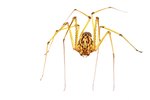Ticks can live up to three years, but they'll live much shorter lives if they do not find a host to feed on. Ticks must feed on blood to complete each stage in their development. Some ticks feed on different species of hosts in each stage, while others have a single host species -- brown dog ticks feed on dogs throughout their lives, for instance. Ticks grow and develop faster in warmer temperatures.
Tick Eggs
Female ticks lay eggs on the ground in the spring. The number of eggs she lays varies based on her size and how much she fed before laying eggs. After mating, a female brown dog tick can lay as many as 5,000 eggs; a deer tick lays approximately 3,000 eggs. Ticks lay their eggs over a period of up to 15 days. Brown dog ticks hatch after about two to five weeks -- the interval varies based on temperature and moisture levels.
Seed Ticks
After hatching, the tick is in the seed tick, or larval, stage of life. At this stage, the tick begins questing or looking for a first host. This is often a dog, rodent or bird. After feeding for several days, the tick will fall back to the ground to molt. In the case of the brown dog tick, the molting process takes approximately two weeks.
Nymph Stage
After molting, ticks enter the nymph stage of life and again begin questing. At this stage, ticks prefer to feed on dogs, rodents and humans. After feeding for several days, the tick again falls to the ground to molt. For the brown dog tick, the second molting process takes approximately five to 10 days.
Adult Ticks
After the second molting, ticks enter adulthood, the final stage of their life cycle. They quest for a third host, usually a dog, deer, human or other pet. Males feed for a short time before falling off the host and dying. Females feed for several days. When they fall off of the host, they live only long enough to lay their eggs.
Ticks can survive for up to five months between feedings, if hosts are scarce. Each stage takes longer in colder temperatures.
References
Photo Credits
-
Goldfinch4ever/iStock/Getty Images
Writer Bio
Maureen Malone started writing in 2008. She writes articles for business promotion and informational articles on various websites. Malone has a Bachelor of Science in technical management with an emphasis in biology from DeVry University.





